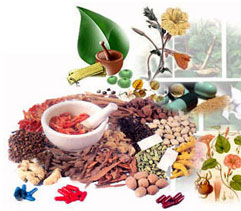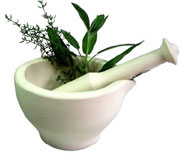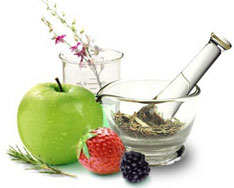Ayurvedic medicine (also called Ayurveda) is one of the world’s oldest medical systems. It originated in India and has evolved there over thousands of years. In the United States, Ayurvedic medicine is considered complementary and alternative medicine (CAM)-more specifically, a CAM whole medical system. Many therapies used in Ayurvedic medicine are also used on their own as CAM-for example, herbs, massage, and specialized diets. This fact sheet provides a general overview of Ayurvedic medicine and suggests sources for additional information.
Key Points
- The aim of Ayurvedic medicine is to integrate and balance the body, mind, and spirit. This is believed to help prevent illness and promote wellness.
- Ayurvedic medicine uses a variety of products and techniques to cleanse the body and restore balance. Some of these products may be harmful if used improperly or without the direction of a trained practitioner. For example, some herbs can cause side effects or interact with conventional medicines.
- Before using Ayurvedic treatment, ask about the practitioner’s training and experience.
- Tell your health care providers about any complementary and alternative practices you use. Give them a full picture of what you do to manage your health. This will help ensure coordinated and safe care.
Background of Ayurvedic Medicine
 Ayurvedic medicine, also called Ayurveda, originated in India several thousand years ago. The term “Ayurveda” combines the Sanskrit words ayur (life) and veda (science or knowledge). Thus, Ayurveda means “the science of life.”
Ayurvedic medicine, also called Ayurveda, originated in India several thousand years ago. The term “Ayurveda” combines the Sanskrit words ayur (life) and veda (science or knowledge). Thus, Ayurveda means “the science of life.”
In the United States, Ayurvedic medicine is considered a type of CAM and a whole medical system. As with other such systems, it is based on theories of health and illness and on ways to prevent, manage, or treat health problems.
Ayurvedic medicine aims to integrate and balance the body, mind, and spirit; thus, some view it as “holistic.” This balance is believed to lead to happiness and health, and to help prevent illness. Ayurvedic medicine also treats specific physical and mental health problems. A chief aim of Ayurvedic practices is to cleanse the body of substances that can cause disease, thus helping to re-establish harmony and balance.
Ayurvedic Medicine in India
Ayurvedic medicine, as practiced in India, is one of the oldest systems of medicine in the world. Many Ayurvedic practices predate written records and were handed down by word of mouth. Two ancient books, written in Sanskrit more than 2,000 years ago, are considered the main texts on Ayurvedic medicine-Caraka Samhita and Sushruta Samhita. The texts describe eight branches of Ayurvedic medicine:
- Internal medicine
- Surgery
- Treatment of head and neck disease
- Gynecology, obstetrics, and pediatrics
- Toxicology
- Psychiatry
- Care of the elderly and rejuvenation
- Sexual vitality.
Underlying Concepts
Ayurvedic medicine has several key foundations that pertain to health and disease. These concepts have to do with universal interconnectedness, the body’s constitution (prakriti), and life forces (doshas).
Interconnectedness: Ideas about the relationships among people, their health, and the universe form the basis for how Ayurvedic practitioners think about problems that affect health. Ayurvedic medicine holds that:
- All things in the universe (both living and nonliving) are joined together.
- Every human being contains elements that can be found in the universe.
- Health will be good if one’s mind and body are in harmony, and one’s interaction with the universe is natural and wholesome.
- Disease arises when a person is out of harmony with the universe. Disruptions can be physical, emotional, spiritual, or a combination of these.
Constitution (prakriti)
 Ayurvedic medicine also has specific beliefs about the body’s constitution. Constitution refers to a person’s general health, the likelihood of becoming out of balance, and the ability to resist and recover from disease or other health problems.
Ayurvedic medicine also has specific beliefs about the body’s constitution. Constitution refers to a person’s general health, the likelihood of becoming out of balance, and the ability to resist and recover from disease or other health problems.
The constitution is called the prakriti. The prakriti is a person’s unique combination of physical and psychological characteristics and the way the body functions to maintain health. It is influenced by such factors as digestion and how the body deals with waste products. The prakriti is believed to be unchanged over a person’s lifetime.
Life forces (doshas)
Important characteristics of the prakriti are the three life forces or energies called doshas, which control the activities of the body. A person’s chances of developing certain types of diseases are thought to be related to the way doshas are balanced, the state of the physical body, and mental or lifestyle factors.
Ayurvedic medicine holds the following beliefs about the three doshas:
- Each dosha is made up of two of five basic elements: ether (the upper regions of space), air, fire, water, and earth.
- Each dosha has a particular relationship to bodily functions and can be upset for different reasons.
- Each person has a unique combination of the three doshas, although one dosha is usually prominent. Doshas are constantly being formed and reformed by food, activity, and bodily processes.
- Each dosha has its own physical and psychological characteristics.
- An imbalance of a dosha will produce symptoms that are unique to that dosha. Imbalances may be caused by a person’s age, unhealthy lifestyle, or diet; too much or too little mental and physical exertion; the seasons; or inadequate protection from the weather, chemicals, or germs.
The doshas are known by their original Sanskrit names: vata, pitta, and kapha.
The vata dosha combines the elements ether and air. It is considered the most powerful dosha because it controls very basic body processes such as cell division, the heart, breathing, discharge of waste, and the mind. Vata can be aggravated by, for example, fear, grief, staying up late at night, eating dry fruit, or eating before the previous meal is digested. People with vata as their main dosha are thought to be especially susceptible to skin and neurological conditions, rheumatoid arthritis, heart disease, anxiety, and insomnia.
The pitta dosha represents the elements fire and water. Pitta controls hormones and the digestive system. A person with a pitta imbalance may experience negative emotions such as anger and may have physical symptoms such as heartburn within 2 or 3 hours of eating. Pitta is upset by, for example, eating spicy or sour food, fatigue, or spending too much time in the sun. People with a predominantly pitta constitution are thought to be susceptible to hypertension, heart disease, infectious diseases, and digestive conditions such as Crohn’s disease.
The kapha dosha combines the elements water and earth. Kapha helps to maintain strength and immunity and to control growth. An imbalance of the kapha dosha may cause nausea immediately after eating. Kapha is aggravated by, for example, greed, sleeping during the daytime, eating too many sweet foods, eating after one is full, and eating and drinking foods and beverages with too much salt and water (especially in the springtime). Those with a predominant kapha dosha are thought to be vulnerable to diabetes, cancer, obesity, and respiratory illnesses such as asthma.
Treatment
Ayurvedic treatment is tailored to each person’s constitution. Practitioners expect patients to be active participants because many Ayurvedic treatments require changes in diet, lifestyle, and habits.
The patient’s dosha balance: Ayurvedic practitioners first determine the patient’s primary dosha and the balance among the three doshas by:
- Asking about diet, behavior, lifestyle practices, recent illnesses (including reasons and symptoms), and resilience (ability to recover quickly from illness or setbacks)
- Observing such physical characteristics as teeth and tongue, skin, eyes, weight, and overall appearance
- Checking the patient’s urine, stool, speech and voice, and pulse (each dosha is thought to make a particular kind of pulse).
Treatment practices: Ayurvedic treatment goals include eliminating impurities, reducing symptoms, increasing resistance to disease, and reducing worry and increasing harmony in the patient’s life. The practitioner uses a variety of methods to achieve these goals:
- Eliminating impurities. A process called panchakarma is intended to cleanse the body by eliminating ama. Ama is described as an undigested food that sticks to tissues, interferes with normal functioning of the body, and leads to disease. Panchakarma focuses on eliminating ama through the digestive tract and the respiratory system. Enemas, massage, medical oils administered in a nasal spray, and other methods may be used.
- Reducing symptoms. The practitioner may suggest various options, including physical exercises, stretching, breathing exercises, meditation, massage, lying in the sun, and changing the diet. The patient may take certain herbs-often with honey, to make them easier to digest. Sometimes diets are restricted to certain foods. Very small amounts of metal and mineral preparations, such as gold or iron, also may be given.
- Increasing resistance to disease. The practitioner may combine several herbs, proteins, minerals, and vitamins in tonics to improve digestion and increase appetite and immunity. These tonics are based on formulas from ancient texts.
- Reducing worry and increasing harmony. Ayurvedic medicine emphasizes mental nurturing and spiritual healing. Practitioners may recommend avoiding situations that cause worry and using techniques that promote release of negative emotions.
Use of plants:
 Ayurvedic treatments rely heavily on herbs and other plants-including oils and common spices. Currently, more than 600 herbal formulas and 250 single plant drugs are included in the “pharmacy” of Ayurvedic treatments. Historically, Ayurvedic medicine has grouped plant compounds into categories according to their effects (for example, healing, promoting vitality, or relieving pain). The compounds are described in texts issued by national medical agencies in India. Sometimes, botanicals are mixed with metals or other naturally occurring substances to make formulas prepared according to specific Ayurvedic text procedures; such preparations involve several herbs and herbal extracts and precise heat treatment.
Ayurvedic treatments rely heavily on herbs and other plants-including oils and common spices. Currently, more than 600 herbal formulas and 250 single plant drugs are included in the “pharmacy” of Ayurvedic treatments. Historically, Ayurvedic medicine has grouped plant compounds into categories according to their effects (for example, healing, promoting vitality, or relieving pain). The compounds are described in texts issued by national medical agencies in India. Sometimes, botanicals are mixed with metals or other naturally occurring substances to make formulas prepared according to specific Ayurvedic text procedures; such preparations involve several herbs and herbal extracts and precise heat treatment.










